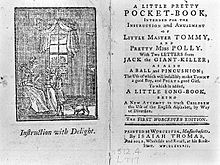John Newbery
| John Newbery | |
|---|---|

Newbery's A Little Pretty Pocket-Book, originally published in 1744
|
|
| Born | 9 July 1713 Waltham St Lawrence, Berkshire, England |
| Died | 22 December 1767 (aged 54) Canonbury House, Islington, London, England |
| Resting place | Waltham Saint Lawrence |
| Occupation | Printer |
| Language | English |
| Genre | children's literature |
| Notable works | The History of Little Goody Two-Shoes |
John Newbery (9 July 1713 – 22 December 1767), called "The Father of Children's Literature", was an English publisher of books who first made children's literature a sustainable and profitable part of the literary market. He also supported and published the works of Christopher Smart, Oliver Goldsmith and Samuel Johnson. In recognition of his achievements in children's publishing, the Newbery Medal was named after him.
Newbery was born in 1713 to Robert Newbery, a farmer, in Waltham St Lawrence, Berkshire, England. When he was younger he gave himself an education. He was apprenticed to a local printer, William Ayers, at the age of sixteen. The business was later sold to William Carnan. In 1737 Carnan died, leaving the business to his brother, Charles Carnan, and Newbery. Two years later, Newbery married William Carnan's widow, Jordan Mary. He adopted Mary's three children, John, Thomas and Anna-Maria. In 1740 their daughter Mary was born. John, born in 1741, died at age 11. Son Francis arrived in 1743.
By 1740 Newbery had started his publishing business in Reading. His first two publications were an edition of Richard Allestree's The Whole Duty of Man and Miscellaneous Works Serious and Humerous [sic] In Verse and Prose. In 1743, Newbery left Reading, putting his stepson John Carnan in charge of his business there, and established a shop in London, first at the sign of the Bible and Crown near Devereux Court. He published several adult books, but became interested in expanding his business to children's books. His first children's book, A Little Pretty Pocket-Book, appeared 18 July 1744.A Little Pretty Pocket-Book is the first in Newbery's successful line of children's books. The book cost six pence but for an extra two the purchaser received a red and black ball or pincushion. Newbery, like John Locke, believed that play was a better enticement to children's good behaviour than physical discipline, and the child was to record their behaviour by either sticking a pin in the red side for good behaviour or the black side if they were bad. A Little Pretty Pocket-Book, though it would seem didactic today, was well received. Promising to "infallibly make Tommy a good boy and Polly a good girl", it had poems, proverbs and an alphabet song. The book was child sized with a brightly coloured cover that appealed to children—something new in the publishing industry. Known as gift books, these early books became the precursor to the toy books popular in the nineteenth century. In developing his particular brand of children's literature, Newbery borrowed techniques from other publishers, such as binding his books in Dutch floral paper and advertising his other products and books within the stories he wrote or commissioned. This improvement in the quality of books for children, as well as the diversity of topics he published, helped make Newbery the leading producer of children's books in his time.
...
Wikipedia
